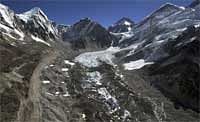Lakes formed by glacier melt, threatening valleys

These lakes can overflow or burst their banks, endangering areas downstream, experts point out.
Himalayan glaciers form headwater of most rivers in northern and eastern India. The Himalayas have the largest concentration of glaciers outside the poles. According to data, 17 per cent of the Himalayas are glaciers while 30-40 per cent of the mountain range gets seasonal snow. There are an estimated 9,500 glaciers in the Indian Himalayas alone.
G M Bhat, professor in the geology department in Jammu University, told reporters: "New lakes have been noticed at the tails of Himalayan glaciers due to faster melting of snow caused by a rise in temperature. "There is no reliable data to say how many lakes have been formed due to this phenomenon, but these lakes are definitely a threat when they overflow or when they breach their banks."
Plus, the water is being held back by the lakes, "which is why rivers are comparatively dry despite faster melting of glaciers," Bhat said. But once these lakes breach their banks -- which are often formed of loose moraine -- "the floods can cause widespread devastation downstream." There have been reports of such glacial lake outburst floods in Bhutan and Nepal.
Bhat said that on a flight to Leh, "we see many new lakes at the snouts of glaciers which were not there 10 years ago". The Himalayan glaciers feed rivers in South Asia, China and parts of Southeast and Central Asia, with about 1.3 billion people directly dependent on these rivers.